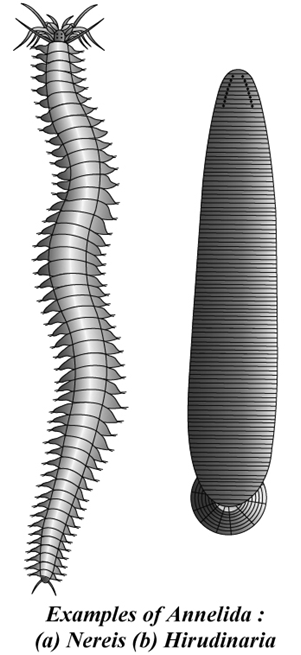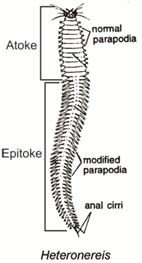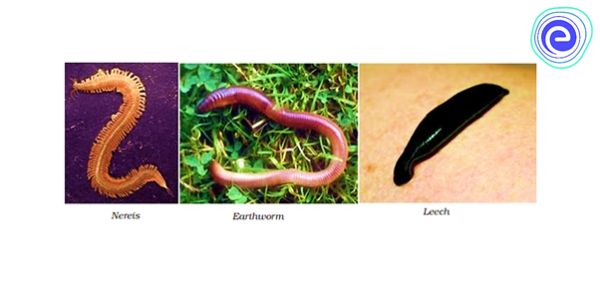- Books Name
- ACME SMART COACHING Biology Book
- Publication
- ACME SMART PUBLICATION
- Course
- CBSE Class 11
- Subject
- Biology
PHYLUM : ANNELIDA
- The phylum includes over 9,000 species of metamerically segmented animals with a true coelom called the Schizocoelom.
General characters of Phylum Annelida

1. The organisms are triploblastic, bilaterally symmetrical, coelomates with organ system level of body organization and are metamerically segmented.
2. Body wall has an epidermis of columnar epithelium coated externally by moist albuminous cuticle and with circular and longitudinal muscle fibres.
3. Chitinous setae, aiding in locomotion, mayor may not be present on fleshy parapodia; absent in leech.
4. Annelids are the first animals to have a true schizocoelic coelom. Coelom is divided by septa into compartments.
5. The coelomic fluid act as a hydrostatic skeleton.
6. Digestive system is complete and digestion is extracellular.
7. Respiration by moist skin (cutaneous respiration) or through gills (Branchial respiration).
8. Blood vascular system is usually closed. Respiratory pigments, either haemoglobin or erythrocruorin, are dissolved in blood plasma. Free amoeboid blood corpuscles are present, butthere are no RBCs. ln leech, there is no true blood vascular system.
9. Nephridia are the excretory organs. Ammonia is chief excretory waste.
10. The nervous system consists of a nerve ring and asolid, double, mid-ventral nerve cord with ganglia and lateral nerves in each segment.
11. Sensory organs include tactile organs, taste buds, statocysts, photoreceptor cells and eyes with lenses.
12. The sexes may be separate (e.g., Nereis) or united (e.g., earthworm, leech).
13. Development is mostly direct (e.g., Earthworm). There is indirect development in Nereis. Larva, when present is trochophore.
CLASSIFICATION OF ANNELIDA
Based on presence or absence/of Parapodia, Setae and Sense organs

NEREIS

Inhabits in sea - shore between tide mark, burrower, nocturnal, carnivorous, gregarious, fertilization - in sea.
Parapodia in each segment except first & last. During breeding body divides in two parts. Anterior asexual part - Atoke and posterior sexual portion Epitoke. This change is known as epitoky.
Phylum Annelida
Phylum Annelida contains around 17000 species. Ringworms and segmented worms are other names for annelids. They can be found in a variety of habitats, including coastal waterways, freshwater, and wet terrestrial places. The annelids can be as small as a few centimeters long or as large as three meters. In addition, some species in this phylum have unusual forms and vibrant colors. Annelids are invertebrate creatures with bilateral symmetry. They are triploblastic and coelomate. Their body surface is divided by segments called metameres. They have longitudinal and circular muscles that let them move around. Nereis and other aquatic annelids have lateral appendages called parapodia that aid in swimming.There is a closed circulatory system in place. Osmoregulation and excretion are aided by nephridia (sing. nephridium). The neural system is made up of paired ganglia (sing. ganglion) coupled to a double ventral nerve cord via lateral nerves. Earthworms and leeches are monoecious, but Nereis, an aquatic variety, is dioecious. Sexual reproduction is prevalent. Nereis,Pheretima (Earthworm), and Hirudinaria are other examples (Bloodsucking leech).


 ACME SMART PUBLICATION
ACME SMART PUBLICATION
